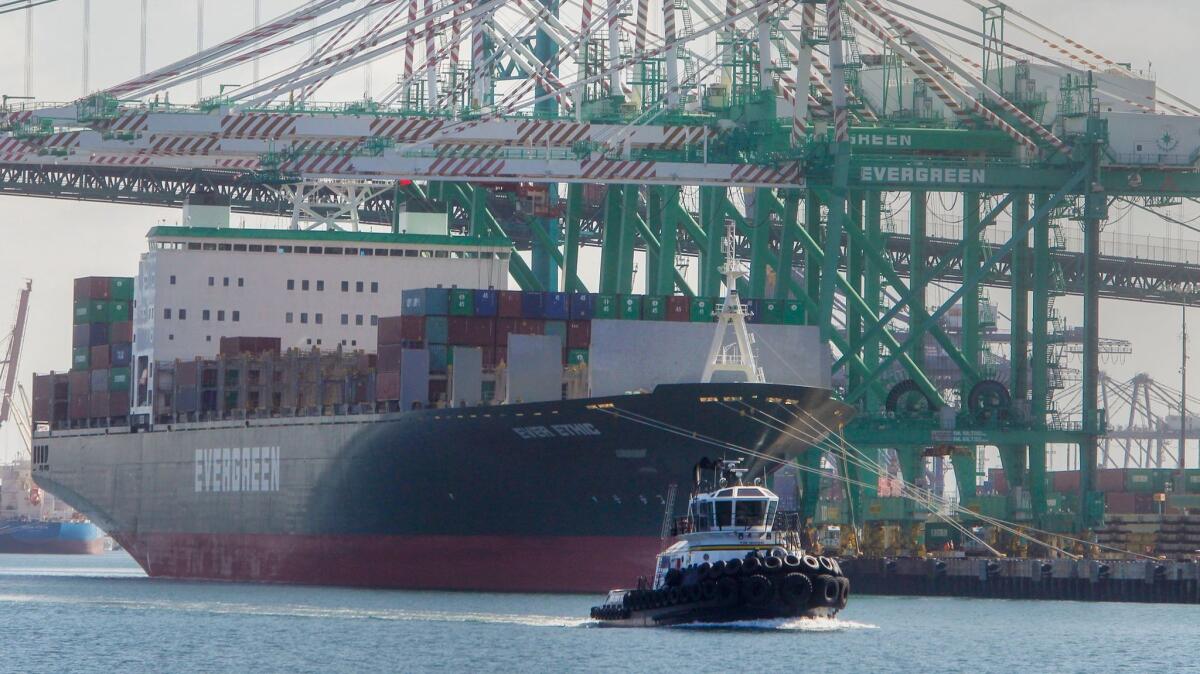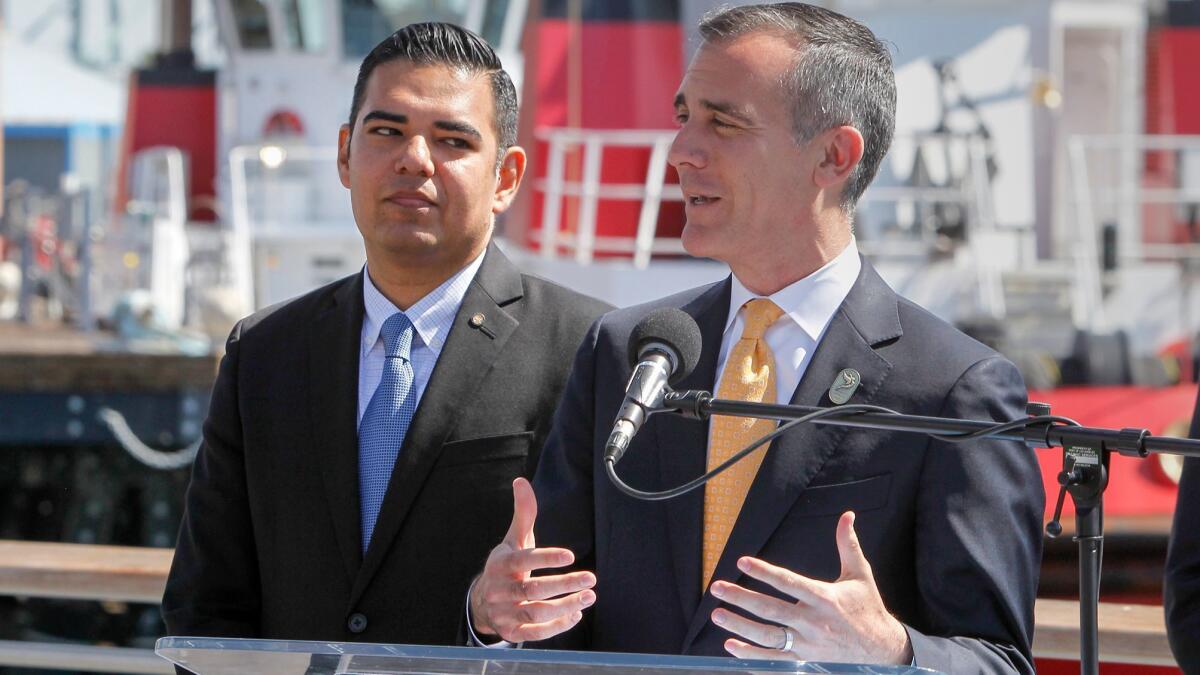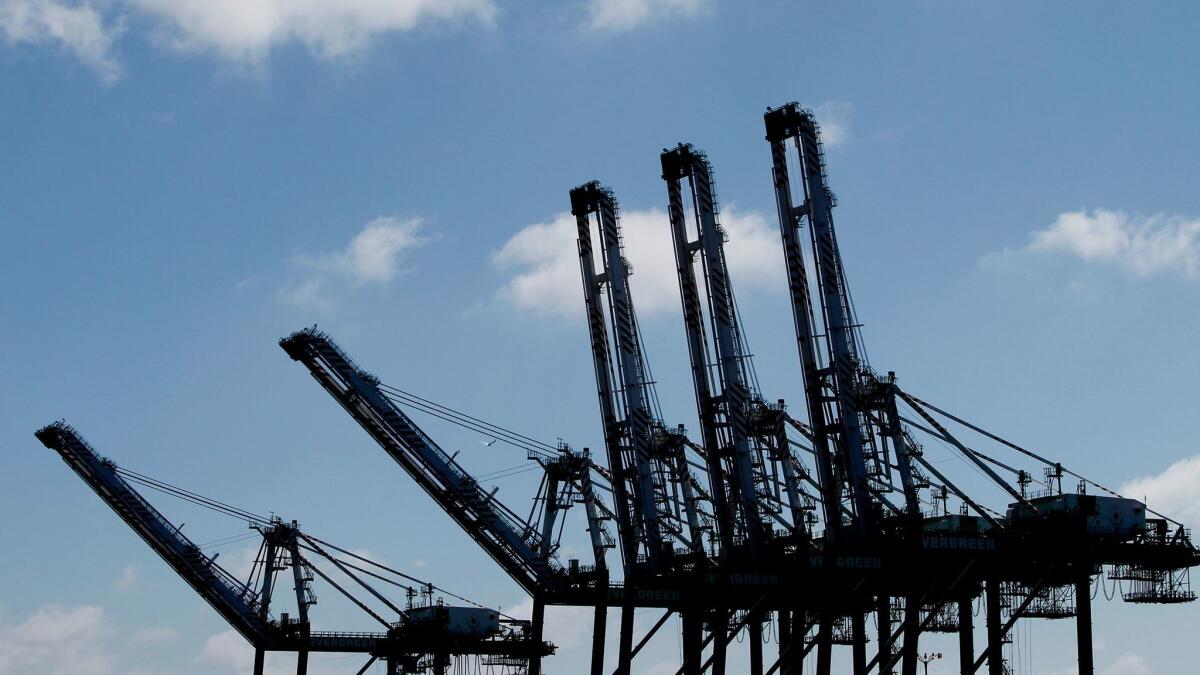L.A. and Long Beach mayors sign pact setting zero-emissions goals for ports

The mayors of Los Angeles and Long Beach signed an agreement Monday directing the nation’s largest port complex to reduce air pollution by moving toward zero-emissions trucks and yard equipment.
The mayors of Los Angeles and Long Beach signed an agreement Monday directing the nation’s largest port complex to reduce air pollution by moving toward zero-emission trucks and yard equipment.
The two-page declaration signed by L.A. Mayor Eric Garcetti and Long Beach Mayor Robert Garcia says the ports “shall advance clean technologies and other efforts to move toward the goal of zero emissions” and establishes targets for zero-emission cargo-handling equipment by 2030 and zero-emission trucks by 2035.
Though the city-owned ports of Los Angeles and Long Beach have made great strides reducing emissions under their joint 2006 Clean Air Action Plan, they remain the largest single source of smog-forming pollution in Southern California. Diesel pollution from thousands of trucks, cargo ships, locomotives and other freight-hauling vehicles serving the complex continues to harm the health of people in surrounding communities.

The mayors’ agreement largely reiterates targets proposed in an updated pollution-reduction plan under development by the ports. But it moves ahead a process that had faced delays and uncertainty in recent months as environmentalists pushed for stricter measures and industry voiced concerns about shouldering the cost.
The document signed Monday commits the ports to approving a new plan by November.
“Some folks have questioned our commitment,” Garcetti said at a news conference at the port complex before signing the agreement. “We’re here to put it down on paper.”
Some folks have questioned our commitment. We’re here to put it down on paper.
— Los Angeles Mayor Eric Garcetti

Garcetti acknowledged that achieving zero-emissions targets won’t be easy, calling it “brave new territory.”
There will be setbacks, he conceded, because science and technology advances may not keep pace with the agreement’s ambitions. “But if we don’t keep pushing, if we don’t have those goals we’ll never get there.”
The agreement also directs the ports to:
- Develop a pilot program to test 50 to 100 zero-emission trucks to stimulate market demand and production by manufacturers
- Further reduce pollution from docked cargo ships through testing and development of emissions control systems
- Expand technology advancement programs to support emissions reductions in the goods movement industry
- Establish a green ports initiative with other West Coast seaports to advance similar goals.
Environmentalists applauded the mayors’ action as a meaningful commitment that would help spur the technology advancements needed to clean the air and improve residents’ health.
Harmful emissions from the ports’ largely diesel-fueled operations worsen smog across the region and pose unacceptable health risks, according to air quality regulators, afflicting harbor-area communities with higher asthma rates and the region’s highest cancer risk from air pollution.
Nidia Erceg, deputy policy director for the Coalition for Clean Air, said the agreement was “the first attempt at having enforceable and quantifiable milestones to convert to zero-emissions yard equipment. That’s been missing from this plan.”
Goods movement industry groups voiced concerns about the economic consequences that moving to costlier, cleaner vehicles. The ports are a major economic engine, with trade passing through them supporting hundreds of thousands of jobs across Southern California.
“It’s pretty aggressive and we need to make sure there are commercially available and viable technologies before we set hard deadlines,” said Weston LaBar, executive director of the Harbor Trucking Assn.
Sylvia Betancourt, project manager for the Long Beach Alliance for Children with Asthma, said “we get it that there are huge costs. But children’s health is at stake and that should be the bottom line.”
Garcetti urged environmentalists and industry to get behind the new clean-air plan, which he said would bring health benefits and boost the economy by fueling demand for clean-energy jobs.
Garcetti also portrayed the move as a response to the Trump administration’s rolling back of air quality rules and other environmental protections, including the recent decision to pull out of the Paris climate accord.
“Washington may not care about clean air or think that environmental justice for people who live near our ports is anything to be concerned about, but you can be damn sure that we do,” Garcetti said.

The announcement comes as state and local air quality regulators move to further clamp down on pollution from ports and other freight-handling operations.
Under a smog-cleanup plan approved in March, the California Air Resources Board must draft regulations to achieve “up to 100%” zero-emission cargo handling equipment by 2030. State and local air regulators are also studying “indirect source” rules that would target emissions from freight hubs including ports, railyards, warehouses and distribution centers.
The move also follows a series of revelations that the Port of Los Angeles failed to impose air quality improvement measures the city agreed to years ago, including mandates that massive cargo ships shut down their engines and plug into shore-based electricity while docked to reduce harmful diesel emissions. The problems occurred at the China Shipping and TraPac terminals, which together handled about one-third of the containers moving through the port.
Garcetti said the port has learned from these failings.
The mayors held their waterfront news conference before a cluster of invited guests that included industry leaders, local officials, environmentalists and groups representing people who live near the ports and have experienced health problems.
Garcetti acknowledged that one reason for publicizing the ports’ latest environmental commitments is to hold himself and other officials accountable for living up to them in front of the people who will suffer if the goals aren’t achieved.
“I think people always wonder whether vague political promises will actually be enshrined in real actions,” he said.
More to Read
Sign up for Essential California
The most important California stories and recommendations in your inbox every morning.
You may occasionally receive promotional content from the Los Angeles Times.










